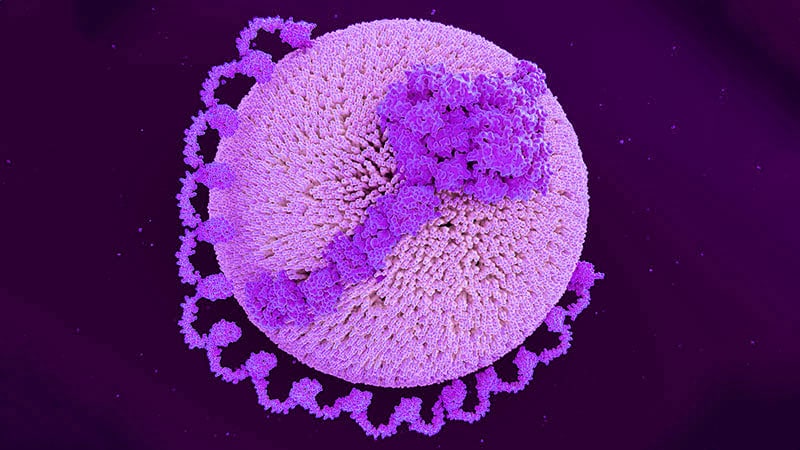Core Concepts
Novel therapies muvalaplin and olpasiran effectively reduce Lp(a) levels with promising safety profiles.
Abstract
Muvalaplin Phase 1 Trial
Investigational muvalaplin aims to lower Lp(a) levels.
Initial studies show significant reductions in Lp(a) with other therapies.
Muvalaplin, a small molecule, disrupts the binding of apolipoprotein(a) to apo B100.
Phase 1 trial in healthy individuals demonstrates up to 65% reduction in Lp(a) levels.
Ongoing phase 2 KRAKEN trial to evaluate efficacy in patients with elevated Lp(a) levels.
Olpasiran OCEAN(a)-DOSE Extended Study
Olpasiran, a small interfering RNA, effectively lowers Lp(a) levels.
Extension study shows sustained reduction in Lp(a) levels close to 1 year after the last dose.
Long-term efficacy and safety being evaluated in phase 3 OCEAN(a)-Outcomes trial.
Exciting results prompt anticipation for further developments.
Muvalaplin and Olpasiran Show Promise in Lowering Lp(a)
Stats
"Lp(a) levels were reduced up to 65% following daily administration of 100 to 800 mg of muvalaplin for 14 days."
"At 36 weeks, doses of 75 mg or more of olpasiran every 12 weeks led to reductions of more than 95% in levels of Lp(a)."
Quotes
"Olpasiran is an siRNA that robustly lowers Lp(a) levels."
"Sustained around a 40% to 50% placebo-adjusted reduction in Lp(a) levels close to 1 year after the last dose."
Key Insights Distilled From
by Marlene Busk... at www.medscape.com 09-18-2023
https://www.medscape.com/viewarticle/996568
Deeper Inquiries
How might the introduction of oral agents like muvalaplin impact the treatment landscape for patients with high Lp(a) levels?
The introduction of oral agents like muvalaplin represents a significant advancement in the treatment landscape for patients with high Lp(a) levels. Currently, available therapies for lowering Lp(a) levels, such as injectable antisense oligonucleotides and RNA interference agents, have limitations in terms of administration and frequency. Muvalaplin being an oral agent offers a more convenient and potentially more patient-friendly option for managing high Lp(a) levels. This could lead to improved adherence to treatment regimens and better long-term outcomes for patients. Additionally, the ability of muvalaplin to lower Lp(a) levels without significantly affecting other lipid parameters like LDL, HDL, or total cholesterol is promising, as it may provide a more targeted approach to reducing cardiovascular risk associated with elevated Lp(a) levels.
What potential challenges or limitations could arise in the long-term use of therapies like olpasiran for lowering Lp(a) levels?
While therapies like olpasiran have shown efficacy in lowering Lp(a) levels in the short term, there are potential challenges and limitations that could arise in their long-term use. One concern is the sustainability of the Lp(a) reduction over extended periods. The need for repeated injections or doses at specific intervals may pose challenges in terms of patient compliance and convenience. Additionally, the long-term safety profile of these therapies needs to be thoroughly evaluated to ensure that there are no unforeseen adverse effects or complications associated with prolonged use. Monitoring for any potential rebound effects on Lp(a) levels after stopping olpasiran treatment is also crucial to understand the implications of discontinuing therapy. Furthermore, the cost and accessibility of these novel therapies could be a limiting factor for widespread adoption and use in clinical practice.
How can the findings of these studies contribute to the broader understanding of genetic and epidemiologic factors influencing cardiovascular disease risk?
The findings of studies on muvalaplin and olpasiran provide valuable insights into the genetic and epidemiologic factors influencing cardiovascular disease risk, particularly in relation to Lp(a) levels. By demonstrating the efficacy of these novel therapies in lowering Lp(a) levels, researchers are shedding light on the potential causal role of Lp(a) in cardiovascular events. Understanding the mechanisms by which muvalaplin and olpasiran target Lp(a) can enhance our knowledge of the genetic pathways involved in lipid metabolism and atherosclerosis. These studies also highlight the importance of personalized medicine approaches in managing cardiovascular risk, as individuals with high Lp(a) levels may benefit from targeted therapies to reduce their risk of CVD events. Overall, the findings contribute to a deeper understanding of the complex interplay between genetic predisposition, lipid profiles, and cardiovascular outcomes, paving the way for more tailored and effective treatment strategies in the future.
0
More on Medical Research
Experts Criticize Slow Progress and Lack of Effective Treatments in $1.6 Billion Long COVID Research Program
Lung Cancer Screening Associated with Earlier Diagnosis and Improved Survival in Retrospective Study of Veteran Patients
Bartonella Bacteria Linked to Increased Risk of Schizophrenia and Psychotic Disorders
